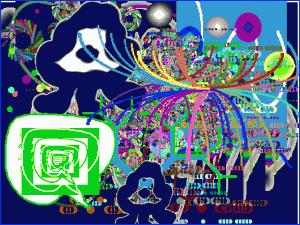Systems and Methods in Hidden Functions
Hideki Nakazawa
10 September – 10 December 2012
.
Japan Times | Japan’s Agency for Cultural Affairs | Art-iT | Bijutsu-Techo / BT | Metropolis | TYO
(English below)
 60年代と70年代のシステミック・ペインティング及びコンセプチュアル・アートに影響された中ザワヒデキの作品は、構造、数学、デジタル技術、グラフィックスの連携により、90年代初頭より日本のアートシーンに挑み続けてきました。中ザワのアートを形作る規則正しい手法への固執は、彼が名付けた「方法主義」という新たな動向を日本の現代美術界にもたらしました。方法絵画、芸術特許、執筆活動、そして90年代半ばに考案されたソフトウェア「デジタルネンド」(1998-2001年に特許を取得した、PCでの3Dビットマップ絵画の制作を促進するプログラム)等の発明により、中ザワのアート制作は発展してきました。これらはクルト・シュヴィッタースのコラージュや「ウルソナタ」の作曲といったダダイスト観念、ソル・ルウィットの概念構造、村上隆の「スーパーフラット」作品等の間を表情豊かに橋架けていると言えるでしょう。
60年代と70年代のシステミック・ペインティング及びコンセプチュアル・アートに影響された中ザワヒデキの作品は、構造、数学、デジタル技術、グラフィックスの連携により、90年代初頭より日本のアートシーンに挑み続けてきました。中ザワのアートを形作る規則正しい手法への固執は、彼が名付けた「方法主義」という新たな動向を日本の現代美術界にもたらしました。方法絵画、芸術特許、執筆活動、そして90年代半ばに考案されたソフトウェア「デジタルネンド」(1998-2001年に特許を取得した、PCでの3Dビットマップ絵画の制作を促進するプログラム)等の発明により、中ザワのアート制作は発展してきました。これらはクルト・シュヴィッタースのコラージュや「ウルソナタ」の作曲といったダダイスト観念、ソル・ルウィットの概念構造、村上隆の「スーパーフラット」作品等の間を表情豊かに橋架けていると言えるでしょう。
本展覧会では中ザワの90年代の作品の現在における関連性が探究され、日本現代美術の新世代に与えた影響が再検討されます。現代美術と批評的課題を日本のサブカルチャーと関連させることへの固執は、間違いなく現在の日本のアートシーンにおけるChim↑Pomや渋家(両者共にThe Containerにて過去に出展)、そして中ザワに続いた「新・方法」アーティストたちの作品を生み出すことに加担したと言えるでしょう。彼の「時代遅れ」なグラフィックス、そしてピクセル及びタイポグラフィを用いたコンセプチュアルな模様の絵画は、今もなお新鮮に目に映り、現代性を強く維持しています。
1996年のインスタレーション「不可視関数試論」では文、音、グラフィックスの関係性の魅力が探られています。「バカCG」と名付けられたグラフィックス描写は、世界中の関連業界に影響を及ぼし、翌年には中ザワのアート制作からほとんど姿を消してしまいました。しかし、インスタレーションの連想的かつ相互作用的な気質には、若い観衆の想像力を捉える子供のような性格、年長の観衆と共鳴するような概念の重なり合いが感じられます。一見レトロなビデオゲームに見えるものの、連想的な言語の使い方は、批判理論の最先端で探究されているようなテキストとイメージの概念的、実用的、そして絵画的な相互関係に対する考察の表れです。
本展では同時に1997年の二つのライトボックス「二九字二九行の文字座標型絵画第一番」と「二九字二九行の文字座標型絵画第二番」が展示されます。これらの作品は中ザワの「方法絵画」を代表し、言葉としては意味を持たない視覚的な模様を形成する概念の実行です。漢字とひらがなを交え、第一番では漢字が中国の五行(木、火、土、金、水)を表し、ビットマップ画像の点の代わりに順番にグリッドに挿入され、第二番ではヒルベルト曲線というフラクタル図形が使われています。漢字の間に逆さまにされたひらがなが、言葉として意味を持たず、あいうえお順に配置されています。ここには偶然は一切ありません―配置は全て入念な計算の基に構成され、数学的順序と完璧な美意識を感じさせる、一分の隙もない構図を作り出しています。
.
Influenced by systemic painting and conceptual art of the 60s and 70s, Hideki Nakazawa’s works forge a connection between structures, mathematics, digital technology and graphics to create pieces that have been challenging the Japanese art scene since the early 1990s. His persistent preoccupation with the systematic techniques he develops and explores to produce his art, established a new movement in contemporary Japanese art coined by Nakazawa as “Methodicism”. These inventions, taking form in method paintings, patents, writings, and the software invention “Digital Nendo” of the mid 90s (patented in 1998-2001 and facilitates 3D bitmap paintings on a PC) have been fuelling Nakazawa’s art ever since and eloquently bridge between Dadaist notions such as Kurt Schwitters’ cut and paste techniques and his Ursonate music compositions, Sol Lewitt’s conceptual structures, and the Superflat works of the likes of Murakami.
This exhibition explores the relevance of Nakazawa’s 1990s pieces nowadays and seeks to reinvestigate their impact on the new generation of contemporary Japanese art. Nakazawa’s obsession with associating contemporary art and critical issues with Japanese subculture no doubt has inspired and assisted the birth of the current art scene of Japan with the works of young collectives such as Chim↑Pom and Shibuhouse (who both exhibited previously at The Container), and the followers of Nakazawa, New Method. His “old school” graphics and conceptual pattern paintings, using pixels or typography, still look fresh as ever and maintain a strong sense of contemporaneity.
The installation Essay on Invisible Functions from 1996 explores his fascination with the relation between text, sound, and graphics. This graphical representation which he named “Silly CG” (silly computer graphics) impacted related industries worldwide and largely has been abandoned by Nakazawa’s art practice the following year. The interactive nature of the installation though and the associative nature of it, has a child-like quality that captures the imagination of young viewers and a conceptual layering that resonates with the older audience. It may look like a retro video game, but his associative use of language examines the conceptual, functional, and pictorial interrelationships of text and image as explored in the most recent critical theory.
The exhibition also presents two light boxes Letter-Coordinate Painting No.1 of 29 Letters by 29 Lines andLetter-Coordinate Painting No. 2 of 29 Letters by 29 Lines both from 1997. The works, represent Nakazawa’s “method paintings,” are a conceptual exercise forming a visual pattern with no intention to create any linguistic sense. Comprising of Chinese characters (Kanji) and Japanese phonetic characters (Hiragana), in painting No. 1, the Kanji letters, represent the Chinese five elements “Gogyo”—tree, fire, earth, gold, and water—which are inserted in order on a grid to replace every dot on a bitmap computer graphic, while painting No. 2, makes use of the fractal method termed the Hilbert Curve. In between the Kanji characters you would find Hiragana letters, as in the alphabetical order, inserted upside-down, devoid of linguistic or phonetic meaning. There are no chances here—every position is immaculately calculated and structured and produces an impeccable composition of mathematical order and perfect aesthetics.
.